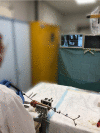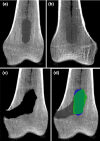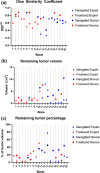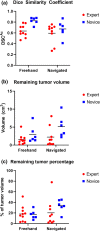The accuracy of navigated versus freehand curettage in bone tumors: a cadaveric model study
- PMID: 36327031
- PMCID: PMC10039836
- DOI: 10.1007/s11548-022-02741-w
The accuracy of navigated versus freehand curettage in bone tumors: a cadaveric model study
Abstract
Purpose: Navigation has been suggested to guide complex benign bone tumor curettage procedures, but the contribution of navigation to the accuracy of curettage has never been quantified. We explored the accuracy of navigated curettage in a cadaveric observational pilot study, comparing navigated to freehand curettage, performed independently by an expert and a novice user.
Methods: The expert performed curettage on 20 cadaveric bones prepared with a paraffin wax mixture tumor, 10 freehand and 10 navigated. We re-used 12 bones for the novice experiments, 6 freehand and 6 navigated. Tumor and curettage cavity volumes were segmented on pre- and post-cone-beam CT scans. Accuracy was quantified using the Dice Similarity Coefficient (DSC), and with remaining tumor volume, bone curettage volume, maximal remaining width and procedure times compared between navigation and freehand groups for both users.
Results: There were little differences in curettage accuracy between a navigated (DSC 0.59[0.17]) and freehand (DSC 0.64[0.10]) approach for an expert user, but there were for a novice user with DSC 0.67(0.14) and 0.83(0.06), respectively. All navigated and freehand procedures had some amount of remaining tumor, generally located in a few isolated spots with means of 2.2(2.6) cm3 (mean 20% of the tumor volume) and 1.5(1.4) cm3 (18%), respectively, for the expert and more diffusely spaced with means of 5.1(2.8) cm3 (33%) and 3.0(2.2) cm3 (17%), respectively, for the novice.
Conclusions: In an explorative study on 20 cadaveric bone tumor models, navigated curettage in its current setup was not more accurate than freehand curettage. The amount of remaining tumor, however, confirms that curettage could be further improved. The novice user was less accurate using navigation than freehand, which could be explained by the learning curve. Furthermore, the expert used a different surgical approach than the novice, focusing more on removing the entire tumor than sparing surrounding bone.
Keywords: Bone; Computer-assisted surgery; Curettage; Navigation; Orthopedic; Tumor.
© 2022. The Author(s).
Conflict of interest statement
The authors declare that they have no conflict of interest.
Figures






References
-
- Martinez M, Hwang J, Beebe KS. Local adjuvants for benign aggressive bone tumors. Curr Orthop Pract. 2014;25:573–579. doi: 10.1097/BCO.0000000000000162. - DOI
Publication types
MeSH terms
LinkOut - more resources
Full Text Sources
Medical

